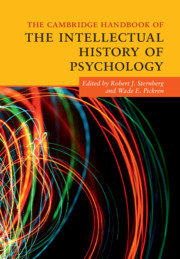Book contents
- The Cambridge Handbook of the Intellectual History of Psychology
- The Cambridge Handbook of the Intellectual History of Psychology
- Copyright page
- Contents
- Figures
- Tables
- Contributors
- Introduction
- 1 Major Paradigms and Approaches in Psychology
- 2 Methodology in Psychology
- 3 Neuroscience in Psychology
- 4 Sensation and Perception
- 5 Attention: Awareness and Control
- 6 Learning
- 7 Memory
- 8 Decision-Making
- 9 Creativity
- 10 Intelligence
- 11 Development
- 12 Social Psychology
- 13 Gender
- 14 Emotion
- 15 Motivation
- 16 Personality
- 17 Abnormal Psychology
- 18 Psychotherapy
- 19 Health Psychology
- Index
- References
14 - Emotion
Published online by Cambridge University Press: 18 May 2019
- The Cambridge Handbook of the Intellectual History of Psychology
- The Cambridge Handbook of the Intellectual History of Psychology
- Copyright page
- Contents
- Figures
- Tables
- Contributors
- Introduction
- 1 Major Paradigms and Approaches in Psychology
- 2 Methodology in Psychology
- 3 Neuroscience in Psychology
- 4 Sensation and Perception
- 5 Attention: Awareness and Control
- 6 Learning
- 7 Memory
- 8 Decision-Making
- 9 Creativity
- 10 Intelligence
- 11 Development
- 12 Social Psychology
- 13 Gender
- 14 Emotion
- 15 Motivation
- 16 Personality
- 17 Abnormal Psychology
- 18 Psychotherapy
- 19 Health Psychology
- Index
- References
Summary
This chapter traces the history of emotion in recent US psychology via examination of the provenance of an artifact published in 1964: a graphic of stick figures exhibiting particular emotional expressions, devised by clinical psychologist Lily Dimitrovsky to facilitate children’s reporting of emotions conveyed by voice. In accounting for this artifact’s emergence, both a macrohistory and a microhistory are advanced. In the macrohistorical account, two contrasting approaches to emotion were current circa 1900. The first, termed interoceptive, focused on the description and quantification of internal emotional phenomenology, while the second, termed exteroceptive, derived from Charles Darwin’s groundbreaking work on facial and postural emotional expression across species. After 1920, both of these approaches fused with motivational concepts, and the interoceptive approach to emotion underwent partial eclipse during that behavioristic era. However, after 1950, the resurgence of cognition and neuroscience in psychology coincided with a revival of emotional theory. The microhistory focuses on local contextual factors that determined the creation of the artifact in a syncretic, emotion-friendly intellectual environment, presaging the way emotion became, between 1965 and the present, a prime component of clinical psychological research and practice as well as a means of communication about social and cultural well-being.
Keywords
- Type
- Chapter
- Information
- The Cambridge Handbook of the Intellectual History of Psychology , pp. 371 - 390Publisher: Cambridge University PressPrint publication year: 2019



